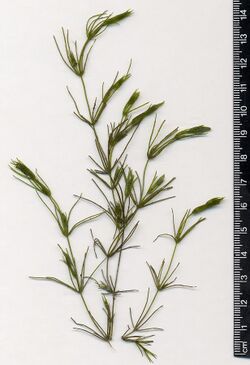Biology:Charophyceae
| Charophyceae | |
|---|---|

| |
| Chara fragilis | |
| Scientific classification Error creating thumbnail: Unable to save thumbnail to destination
| |
| (unranked): | Archaeplastida |
| (unranked): | Viridiplantae |
| (unranked): | Charophyta |
| Class: | Charophyceae Rabenhorst[1] |
| Orders[1] | |
Charophyceae is a class of charophyte green algae. AlgaeBase places it in division Charophyta.[1] Extant (living) species are placed in a single order Charales,[2] commonly known as "stoneworts" and "brittleworts". Fossil members of the class may be placed in separate orders, e.g. Sycidiales and Trochiliscales.[1]
Charophyceae is basal in the Phragmoplastophyta clade which contains the embryophytes (land plants).[3][4][5] In 2018, the first nuclear genome sequence from a species belonging to the Charophyceae was published: that of Chara braunii.[6]
Description
The thallus is erect with regular nodes and internodes. At each node there is a whorl of branches. The whole plant is calcified and Equisetum-like. The internodes of the main axis consist of a single elongated cell, in Chara the internodes are corticated covering the main axis. In other genera these are absent. Where there is a single row of cortical cells the cortex is referred to as diplostichous, where there are two rows of cortical cells it is termed triplostichous. The intermodal cells elongate and do not divide, they become many times longer than broad.[7]
Evolution
Below is a consensus reconstruction of green algal relationships, mainly based on molecular data.[8][9][10]
| Streptophyta/ |
| |||||||||||||||||||||||||||||||||||||||||||||
| charophyta |
References
- ↑ 1.0 1.1 1.2 1.3 Guiry, M.D.; Guiry, G.M. (2025). "Charophyceae". AlgaeBase. World-wide electronic publication, National University of Ireland, Galway. http://www.algaebase.org/browse/taxonomy/?id=4348.
- ↑ Ecological Biochemistry: Environmental and Interspecies Interactions
- ↑ Hoek, C. van den, Mann, D. G. & Jahns, H. M. 1995. Algae: An Introduction to Phycology. Cambridge University Press, Cambridge. ISBN:0-521-30419-9
- ↑ Streptophytina
- ↑ McCourt, R. M., Chapman, R. L., Buchheim, M. & Mishler, B. D. “Green Plants”. Accessed 13 December 2007
- ↑ Nishiyama, Tomoaki; Sakayama, Hidetoshi; de Vries, Jan; Buschmann, Henrik; Saint-Marcoux, Denis; Ullrich, Kristian K.; Haas, Fabian B.; Vanderstraeten, Lisa et al. (July 2018). "The Chara Genome: Secondary Complexity and Implications for Plant Terrestrialization". Cell 174 (2): 448–464.e24. doi:10.1016/j.cell.2018.06.033. PMID 30007417.
- ↑ Smith, G.M. Cryptogamic Botany. Second Edition. 1955.p 121-130. McGraw-Hill Book Company.INC.
- ↑ Linzhou Li; Sibo Wang; Hongli Wang; Sunil Kumar Sahu; Birger Marin; Haoyuan Li; Yan Xu; Hongping Liang et al. (22 June 2020). "The genome of Prasinoderma coloniale unveils the existence of a third phylum within green plants". Nature Ecology & Evolution 4 (9): 1220–1231. doi:10.1038/s41559-020-1221-7. PMID 32572216.
- ↑ Puttick, Mark N.; Morris, Jennifer L.; Williams, Tom A.; Cox, Cymon J.; Edwards, Dianne; Kenrick, Paul; Pressel, Silvia; Wellman, Charles H. et al. (2018). "The Interrelationships of Land Plants and the Nature of the Ancestral Embryophyte". Current Biology 28 (5): 733–745.e2. doi:10.1016/j.cub.2018.01.063. PMID 29456145.
- ↑ Sánchez-Baracaldo, Patricia; Raven, John A.; Pisani, Davide; Knoll, Andrew H. (2017-09-12). "Early photosynthetic eukaryotes inhabited low-salinity habitats". Proceedings of the National Academy of Sciences 114 (37): E7737–E7745. doi:10.1073/pnas.1620089114. PMID 28808007. PMC 5603991. https://research-information.bristol.ac.uk/ws/files/132985852/pnas.1620089114.sapp.pdf.
Wikidata ☰ Q1208690 entry
 |

